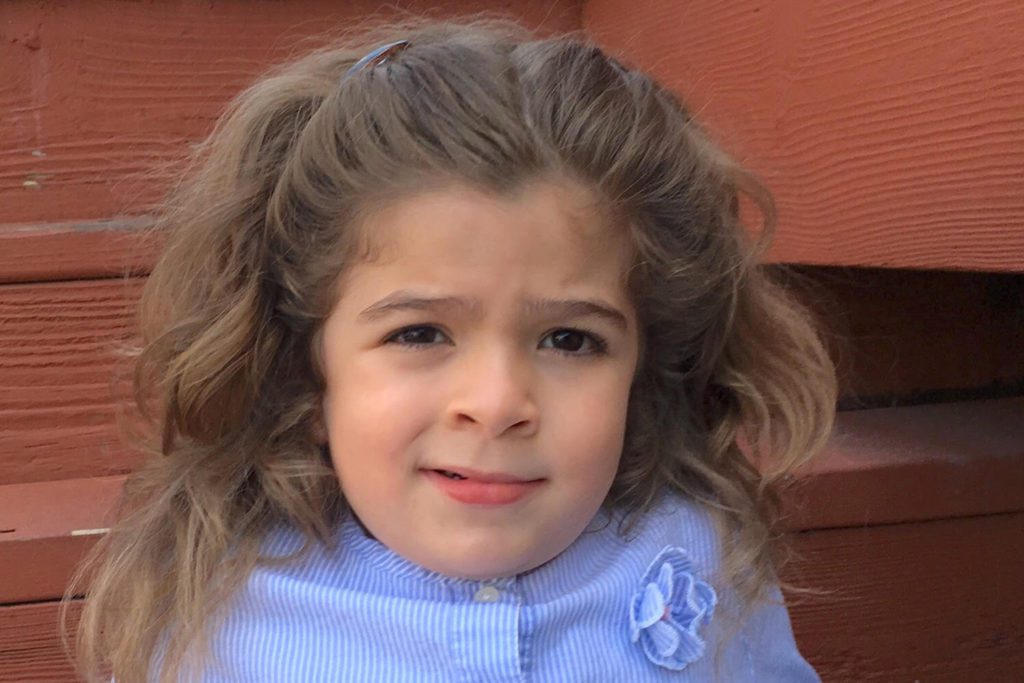FDNA highlighted metabolic disorders and LSDs during May for the Year of Discovery. We are uniting healthcare, advocacy and technology for rare disease advancements. Every case uploaded in May was matched with a $1 donation sponsored by Blueprint Genetics, benefiting the National MPS Society.* Every time a patient’s case is analyzed by Face2Gene, the de-identified information will train the system to recognize new associations between phenotypes, facial characteristics and genes. This information will improve our understanding of rare diseases and directly impact the lives of patients and families for years to come.
Mucopolysaccharidosis IIIB
Mucopolysaccharidosis III (MPSIII), also known as Sanfilippo Syndrome, is an inherited lysosomal storage disorder characterized by gene mutations that cause enzyme deficiencies, which prevent the body from breaking down large sugar molecules (glycosaminoglycans). Four of these gene mutations have been identified and are differentiated as MPSIIIA, MPSIIIB, MPSIIIC and MPSIIID.
These syndromes are not typically apparent at birth but develop throughout childhood, causing developmental regression, progressive intellectual disability, behavioral problems and other symptoms. All MPSIII syndromes present similar signs and symptoms, though often less pronounced than other types of mucopolysaccharidosis. Physical features can include “coarse” facial features, a large head, enlarged livers, hernias and skeletal abnormalities.
Miriam Journey with Mucopolysaccharidosis IIIB
Miriam is a happy, hyperactive 6-year-old who loves to run, watch Doc McStuffins or Mickey Mouse Clubhouse on her iPad, and listen to music. She likes climbing stairs and is thrilled when people sing to her. Miriam was diagnosed with a rare disease known as MPS IIIB at the age of 4. Her diagnostic journey began at the age of 2 when her parents began noticing speech and mild sensory issues, though she was meeting physical milestones.
“We first had concerns around age 2 when her speech development never progressed into the ‘word explosion’ phase and a few words that she once spoke suddenly disappeared and she could no longer say them no matter how much we coaxed her,” said Miriam’s mother, Kathy.
Miriam began weekly speech therapy sessions at the age of 2 but by age 3, her parents and doctors were sure she was experiencing developmental regression. She entered special education preschool, continued with speech therapy, and started regular occupational and physical therapy sessions as well. Miriam’s physician recommended her parents schedule an appointment with a developmental pediatrician but the waiting list for the specialist in their area was over a year long.
Miriam’s parents needed answers sooner. In the meantime, they heard suggestions from doctors, teachers and other healthcare professionals who knew Miriam.
Miriam’s special education teacher recommended a hearing test, thinking that perhaps hearing impairment was the reason Miriam was unable to learn a new language. Unfortunately, that test would present some challenges. At the first session, Miriam wouldn’t cooperate and was unable to be sedated because the clinicians found she had enlarged adenoids which compromised her breathing. Some months later, they were finally able to anesthetize Miriam and perform an Auditory Brainstem Response test (ABR). The ABR revealed that she had mild to moderate sensorineural hearing loss in both ears, a common type of hearing loss usually caused by damage to the inner ear or nerves pathways leading to the brain. The family was referred to a neurosurgeon to determine what was causing Miriam’s hearing loss.
Advice also came from Miriam’s physical therapist around this time. She had worked with a pair of siblings who had similar symptoms to Miriam; these siblings had been diagnosed with Sanfilippo Syndrome. She suggested scheduling an appointment with a geneticist.
The appointment with the neurosurgeon was first. He ordered an MRI and saw white matter, indicative of brain damage. He suspected an inherited metabolic condition and helped to reschedule Miriam’s appointment with the geneticist for the very next day.
Genetic Testing
The geneticist ordered tests looking for MPS I, II, and III. After years of searching for answers, Kathy received a call just one week after the testing panels had been sent off. She was told that Miriam had Mucopolysaccharidosis IIIB, that it was life-threatening, and that there was no cure. The disease has been described as relentlessly progressive and debilitating.
“Many compare it to a childhood version of Alzheimer’s or Dementia because of the way it attacks the brain and how children forget basic skills,” said Kathy.
With this diagnosis, Kathy began learning everything she could about MPSIIIB. She connected with other families of “rare” children and parents of children with MPS III online and on Facebook. These communities provided an essential support network for the family and allowed them to discuss care methods specific to these children.
“I’ve learned how lonely it can seem to have a rare disease. We don’t have anyone physically nearby who understands what we are going through and we must rely on social media to connect with others,” said Kathy.
Raising a child with a disorder like this one can present many challenges. Miriam is almost completely non-verbal, unable to express herself through speech, and unable to take direction through listening. Despite this, Miriam is a strong problem solver and very mobile. The family has found ways to keep Miriam safe—both in public and at home.
“We have taken more safety measures for Miriam now that we know she cannot actually follow directions. We have added more safety proofing to our house, various gates, door alarms, and child-safe knobs.”
Miriam has a secure and stable activity chair at the dining room table that she can’t tip over. When they are out in public, she is often in a pediatric wheelchair that looks more like a stroller. For walks, a heavy-duty harness keeps Miriam safe. Both of these prevent Miriam from wrestling out of her mother’s grip and into traffic or other dangerous situations. Kathy said that the wheelchair is especially helpful for long distances as one feature of MPS IIIB is low muscle tone and Miriam will often drop to the floor if she does not want to continue on.
“She is very similar to a child on the autism spectrum in many of her behaviors and she does thrive on routine,” said Kathy. “She has lots of sensory issues and loves to chew and put everything in her mouth. She does not have as many behavioral challenges though. She has a high pain tolerance, which is both a blessing and a curse as we may not know if she has seriously hurt herself.”
Gene Therapy
Besides the daily management of Miriam’s condition, treatment is also part of the family’s regular routine. this topic, Kathy believes gene therapy is the best hope for patients with MPS IIIB but early screening and treatment are crucial before permanent damage occurs. Miriam undergoes an MRI and lumbar puncture every 12 weeks. She is currently being treated with enzyme replacement therapy through a port in her chest as part of a clinical trial in the US. Kathy tells parents of other rare children to connect with support groups, stay up to date on the latest research, and use patient registries. She encourages parents to launch research, fundraising, and patient registries if these resources aren’t available.
The average family of a child with a rare disease spends 7 years and sees seven doctors before they even hear a diagnosis. Miriam’s family spent 4 years searching for answers and a diagnosis as Miriam’s health declined. 1 in 10 people are affected by a rare disease. Collectively these diseases aren’t rare, but recognizing and accurately diagnosing them is still a challenge. We developed Face2Gene to help clinicians so they can diagnose patients faster. By leveraging new technologies like facial analysis, deep learning, and AI, we can accelerate diagnostics, therapeutics, and research for rare patients.
Families and Patients: Ask your doctor to add your or your child’s case to Face2Gene. The personal information will only be accessible to your doctor, but the de-identified data may help others who are battling a rare disease. Click here for more information.
Healthcare Professionals: Do you have cases to upload that can help Face2Gene recognize metabolic conditions or LSDs and accelerate advancements? Upload them through the app or at Face2Gene.com.
About the National MPS Society
The National MPS Society exists to find cures for MPS and related diseases. We provide hope and support for affected individuals and their families through research, advocacy, and awareness of these devastating disorders. Learn more at www.mpssociety.org.
Face2Gene CLINIC is a free, HIPAA-compliant search & reference tool for healthcare professionals. Face2Gene is provided for informational purposes and not intended to replace the clinician’s judgment or experience, nor should it be used to diagnose or treat medical conditions.
*All donations are provided directly by the participating sponsor in such month and at its sole responsibility. Amounts may be capped to a maximum in each month, at the participating sponsor’s sole discretion.



